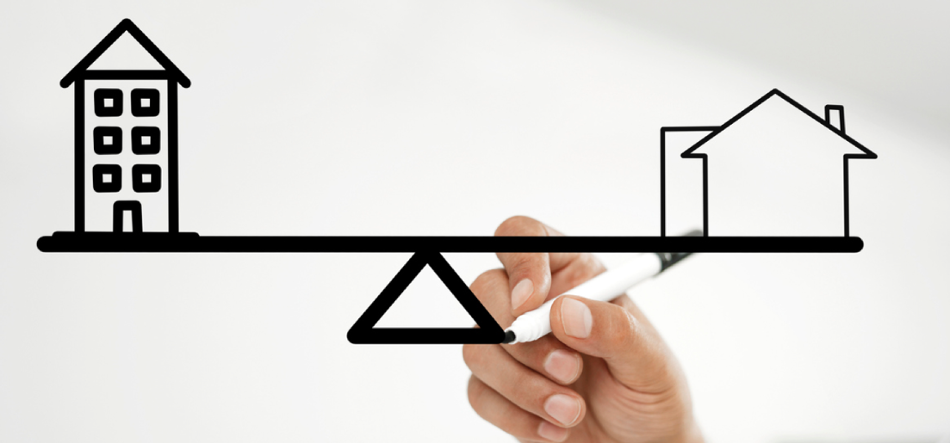Rents for single-family rental (SFR) homes are soaring, while occupancy rates are reaching all time highs, attracting new investors to the asset class. While the demand for rental property is strong almost everywhere, oftentimes the best opportunities are found outside of an investor’s own backyard.
Two of the most popular platforms for remotely investing in single-family rental property are Roofstock and Doorvest. Let’s take a look at the similarities and differences between the two companies, along with the pros and cons of each, to help determine which is the right choice depending on your investing preference and goals.

How Roofstock and Doorvest work
Both Roofstock and Doorvest help people remotely invest in single-family rental homes. However, there are significant differences between the way these two online platforms work that an investor should be aware of.
Roofstock is a good choice for people who want complete control over their investment. A buyer can research hundreds of rental properties listed for sale on the Roofstock Marketplace in over 70 of the hottest real estate markets, many with tenants in place.
Once a property is located, a buyer negotiates their terms, performs desired due diligence such as a property inspection and reviewing tenant documents, and completes the entire transaction online with assistance from the Roofstock team. After the transaction closes, an investor may choose to self-manage the property or hire a local property manager. If the buyer needs a recommendation, Roofstock has a list of vetted property management companies to consider.
On the other hand, Doorvest currently operates only in Houston, Texas. Instead of shopping for a property and doing their own due diligence, a buyer describes their ideal single-family investment home to Doorvest by answering a few questions. Then, the buyer gives Doorvest a fully-refundable deposit to prove that they are serious about purchasing a rental property.
When a home is located, a buyer gives Doorvest authorization to purchase the home. The company makes any needed repairs, finds a long term tenant, and re-sells the home to the buyer with the cost of renovations “baked” into the non negotiable purchase price.
Doorvest does not allow a client to do their own inspections or have a say in the renovations, but will share the inspection report with a buyer to ensure full transparency. Even though a buyer owns the home directly, they must commit to a 1 year management contract with Doorvest, and may only switch managers or sell the home after the first year.
In addition to the process for investing, the way that Roofstock and Doorvest make money is also different.
Investors buying or selling property using the Roofstock Marketplace pay a small, one-time transaction fee. If an investor hires a local property manager on-going fees are paid directly to the management company. Doorvest makes money two ways - by some margins on home sales and with a required management fee of 10% of the monthly rent for the first year.
Roofstock
Roofstock is a good choice for people who want direct control over their investments. Single-family rental property and small multifamily buildings with 2-4 units can be purchased directly from a seller on the Roofstock Marketplace using a process similar to a traditional residential transaction.
Roofstock also provides buyers with 3 other options for investing in real estate. An investor may purchase a newly built home from Lennar, one of the top American home builders in the U.S. Roofstock One allows accredited investors to buy shares of tracking stock tied to the economic performance of single family rental portfolios, and institutional and large investors can purchase portfolios of single-family rental homes.
To help buyers perform their due diligence, Roofstock vets property markets and assigns ratings to each neighborhood using key metrics such as neighborhood characteristics, school district ranking, and crime rate.
After the transaction closes, Roofstock can introduce a buyer to a pre-screened preferred local property management company, if desired, to handle the daily maintenance and management of the property, making it easier to invest in real estate remotely.
Fee structure
The fee structure on Roofstock is similar to buying or selling with a real estate agent, but at a lower cost:
- Sellers pay a 3% fee of the sale price or $2,500 (whichever is greater).
- Buyers pay a fee equal to 0.5% of the purchase price, or $500 (whichever is greater).
- No recurring fees are paid to Roofstock after the initial sales transaction.
Feature summary
Roofstock makes research and due diligence easy with street views and property photos, floor plans, property inspection and title reports, current tenant lease information, and a rent roll showing the tenant’s payment history. After selecting a rental property to purchase, a buyer and seller negotiate, sign a purchase and sale agreement, and close on the rental property on Roofstock.
A customized search of available properties on the Roofstock Marketplace can be performed using key metrics including:
- Location
- List price
- Neighborhood rating
- Minimal repairs
- 2-4 units
- Turnkey
- 1% rule
- Best schools
- Higher appreciation
- Price reduced
- Higher yield
- Gross yield
- Cap rate
- Annual appreciation
- Monthly rent
- Section 8
- Cash only
Pros
- 100% direct ownership of the property with no limitation on how or when the property can be sold.
- No requirement to use a Roofstock vetted property manager to handle the daily maintenance and management of the rental property.
- Single-family houses, small multi-family homes, and entire portfolios of residential rental property are available for purchase in dozens of real estate markets across the U.S.
- No earnest money deposit paid until after a deal has been negotiated and a purchase and sale agreement signed.
- Low one-time transaction fees, optional, vetted local property managers, and efficient closings that are facilitated by Roofstock.
- Due diligence can be easier with single-family houses and small multifamily buildings that are already listed for sale versus a home purchased by a company and re-sold to an investor.
- Cash flow begins immediately with property that has been pre-inspected and is already leased to qualified tenants instead of waiting for repairs to be done and a tenant to be located.
- Easy way to passively invest in long-distance real estate in major, secondary, and tertiary markets across the U.S.
- Liquidity of the real estate investment is increased because a secondary market for rental properties is always available, and investors can re-sell using the Roofstock platform if they choose to do so.
- Retirement accounts and 1031 exchanges may be used to invest in property through the Roofstock platform.
Cons
- Financing a rental property requires a high minimum investment to make a down payment or when purchasing a property for all cash.
- Ongoing maintenance, repairs, and capital improvements may require an investor to contribute additional capital.
- Real estate is an long-term investment and may take time to sell if money is needed for other uses.
Doorvest
Doorvest is a full-service real estate investing platform designed to help investors own high-yield rental homes entirely online. The company was launched in 2018 to help working professionals who did not have the time, resources, experience, or capital to invest in real estate traditionally. Since then, Doorvest has expanded its scope to help investors from all backgrounds to own a rental home.
Doorvest uses the following process to help investors with no prior experience own high-yield single-family rental homes:
- Buyer customizes an ideal investment home by taking 10 minutes to answer questions about themselves and their ideal home.
- After receiving a fully-refundable deposit used toward the home purchase, Doorvest will begin sourcing homes that fit a buyer’s ideal investment home, a process that takes between 3-4 weeks due to the company’s waitlist.
- Once the perfect home is identified, Doorvest will buy the home, renovate it, and place a long term tenant, with the entire process taking about 2 months.
- Doorvest re-sells the home to a buyer at fair market value, and with assistance from the company's Transactions Team the transaction will close in about 1 month.
- Buyer is required to commit to a 1-year management contract allowing Doorvest to manage the home for 1 year with a 10% monthly management fee, after which time property management can be switched or the home can be sold.
Fee structure
Doorvest makes money through two revenue streams:
- Some margin on the sale of a home, although the company claims to sell at a fair market value.
- Property management fee of 10% of the monthly rent, with a buyer required to commit to a 1-year management contract with Doorvest.
Feature summary
Doorvest typically looks for single-family detached homes built after 1970 with 3 bedrooms, 2 bathrooms, and a 2 car garage. Homes with these characteristics are most attractive to long term tenants and have historically appreciated the most, according to the company.
Homes are sourced through a network of real estate agents and wholesalers. Doorvest determines on a case-by-case basis what renovations a home needs to be in rent-ready condition using standardized benchmarks the company has created. Doorvest does not allow an owner to have a say in renovations, because the company’s clients prefer a passive investment where they can be hands off.
The Doorvest Renovation Guarantee ensures that a home is resident ready. The company will cover any costs incurred by an owner to fix renovations done by Doorvest for one year after closing, up to an aggregate limit of $25,000, with a $5,000 limit on individual claims.
Rental income is also guaranteed by Doorvest for the first 12 months of ownership. An owner will receive the rental income quoted by the company regardless of whether or not a resident is paying. If a home is not listed on an MLS, estimated rental income is determined by Doorvest using various data, and Doorvest may lower the estimated market rent rate if a home is not leasing at the original estimated rent.
The Doorvest investor portal provides an owner with a comprehensive breakdown of monthly cash flow, property activity, legal documents, and reports.
Pros
- Doorvest locates a single-family rental home based on a buyer’s criteria.
- Renovations are performed by Doorvest to make a home rent-ready and are guaranteed for 12 months after the sale closes.
- Fee to find a tenant is included in the 10% monthly management fee.
- Residents are selected using extensive criteria in line with the Fair Housing Act, and are required to meet Doorvest’s guidelines for income, credit score, eviction, felony, bankruptcy, and rental history.
- Estimated rental income is also guaranteed for 12 months, and there is no management fee charged if the home is vacant.
- Doorvest property management is 100% in-house, and each home is assigned a manager who is familiar with the property and residents.
Cons
- $35,000 minimum is required to invest in a rental home with Doorvest.
- Homes are only available in Houston, Texas.
- Buyer is unable to select their own home to invest in and must rely on Doorvest to locate an ideal rental property based on a buyer's criteria.
- Doorvest does not allow a buyer to have a say in renovations, nor to perform their own property inspection.
- Final home purchase price to a buyer is non negotiable, with all homes renovated and re-sold to Doorvest clients at fair market value, as determined by data compiled by Doorvest.
- Home renovations are “baked into” the final purchase price, and Doorvest receives a margin on the sale of a home to a buyer.
- Buyer is required to commit to a 1-year property management contract with Doorvest, which renews annually until canceled.
- Beyond the first year a buyer may switch property managers or sell the home.
Roofstock or Doorvest: How to choose?
Both Roofstock and Doorvest aim to simplify the process for remote real estate investing in single-family rental homes, but they do so in completely different ways.
Roofstock is a good match for an investor who prefers to do their own homework and have complete control of their investment. There are hundreds of homes listed for sale on the Roofstock Marketplace in over 70 of the hottest real estate markets from coast to coast. An up-front deposit is not required, an investor may perform their own due diligence, and choose their own property manager.
Doorvest may be a good option for an investor who prefers to be completely hands-off. The company has been described as modernizing fix-and-flip by buying a home, fixing it up and renting it out, before selling it back to a Doorvest investor.
An investor looking for direct control over an income-producing single-family rental home may find Roofstock the preferred choice. On the other hand, Doorvest may be a better choice for an investor who prefers to provide the capital to purchase a fixer-upper, let someone else take care of the renovations and finding a tenant, and then re-purchase the home for its after repair value.









